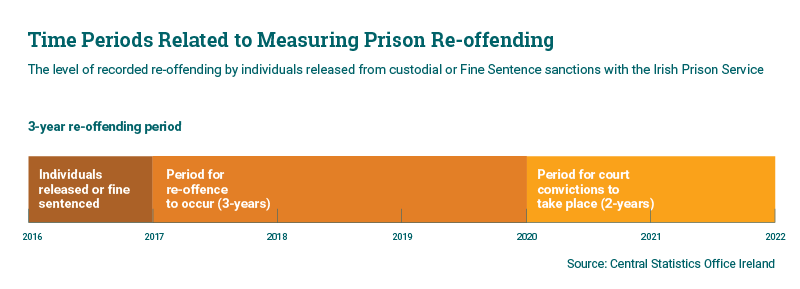Your feedback can help us improve and enhance our services to the public. Tell us what matters to you in our online Customer Satisfaction Survey.
These statistics are categorised as Under Reservation. This categorisation indicates that the quality of these statistics do not meet the standards required of official statistics published by the CSO.
For further information please refer to the Under Reservation FAQ page.
This chapter outlines some more details about individuals who re-offended within three years of release from custody, and who secured a court conviction within a further two years.

Younger adults released from custody continue to have a higher likelihood of re-offending. In 2016 over eight out of ten (82.8%) individuals under the age of 21 re-offended within three years of being released. In comparison, the three year re-offending rate for over 50’s was under one third (29.8%). See Table 3.1 and Figure 3.1.
| Re-offended within 3 years | |
| < 21 years | 82.8 |
| 21 - 25 years | 72.1 |
| 26 - 30 years | 70.4 |
| 31 - 35 years | 62.2 |
| 36 - 40 years | 52.8 |
| 41 - 50 years | 52 |
| Aged 50 and over | 29.8 |
Over eight in ten (82.6%) individuals released from custodial sentences in 2016 for serving sentences relating to Public Order offences re-offended within three years of release. This offence group typically includes offences related to threatening or insulting behaviour, trespassing and a failure to comply with directions given by a member of An Garda Síochána. Individuals released from custody in 2016 in relation to the offence groups Damage to Property and the Environment (79.7%) and Burglary (76.8%) were the next most likely to re-offend within three years. In contrast, individuals released from custody in relation to Sexual Offences (23%) were the least likely to re-offend. This offence group contains offences such as rape, sexual assault and indecent assault. See Table 3.2 and Figure 3.2.
Note: The offence type that individuals are released from custody does not always correspond to the same re-offence type for the individual. Table 3.3 of this publication provides details of three year re-offence types.
| Re-offended within 3 years | |
| 13 Public Order and Other Social Code Offences | 82.6 |
| 12 Damage to Property and to the Environment | 79.7 |
| 07 Burglary and Related Offences | 76.8 |
| 08 Theft and Related Offences | 73.2 |
| 06 Robbery, Extortion and Hijacking Offences | 68.8 |
| 04 Dangerous or Negligent Acts | 61.8 |
| 11 Weapons and Explosives Offences | 60.6 |
| 03 Attempts/Threats to Murder, Assaults, Harassments and Related Offences | 60.1 |
| 09 Fraud, Deception and Related Offences | 56.4 |
| 14 Road and Traffic Offences | 53.1 |
| 05 Kidnapping and Related Offences | 47.1 |
| 15 Offences against Government, Justice Procedures and Organisation of Crime | 46.4 |
| 01 Homicide and Related Offences | 45.7 |
| 10 Controlled Drug Offences | 45.1 |
| 16 Offences not elsewhere Classified | 36.7 |
| 02 Sexual Offences | 23 |
A total of 327 out of the 1,636 re-offenders (20%) from individuals released in 2016 re-offended in offences related to theft while 321 out of the 1,636 (19.6%) re-offended in offences related to Public Order and Other Social Code Offences.
Of the total 241 individuals that re-offended after release in 2016 from serving sentences related to Homicide (16), Sexual Offences (17) or Attempts/Threats to Murder or Assaults (208), just 22 (9.1%) overall committed re-offences within the same offence types as their custodial related offence. Re-offending indicators related to these groups indicate the most likely re-offending category was Public Order and Other Social Code Offences (58 out of 241 or 24.1% of this group). See Table 3.3.
Almost seven out of ten females (69.7%) re-offended within three years of release from custody in 2016. Although the re-offending rate was higher than the male re-offending rate of 61.7% for the same period, just 208 out of the 2,626 individuals that were released from custody in 2016 (8%) of the release population were female. See Table 3.4 and Figure 3.3.
| Re-offended in 3 years | |
| Male | 92.1 |
| Female | 7.9 |
Learn about our data and confidentiality safeguards, and the steps we take to produce statistics that can be trusted by all.